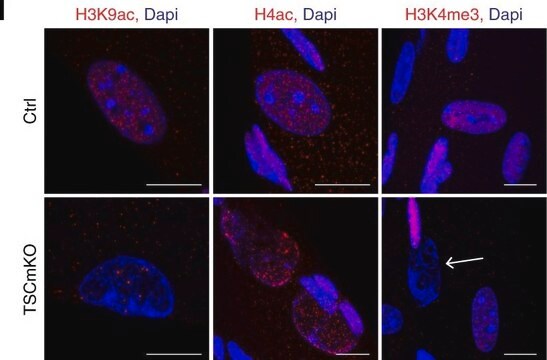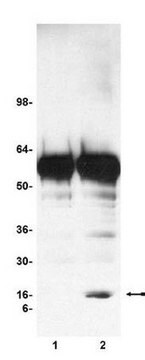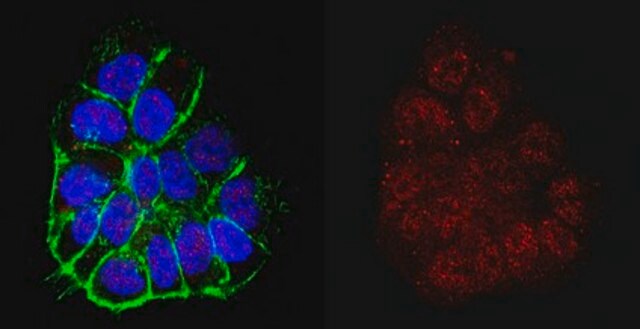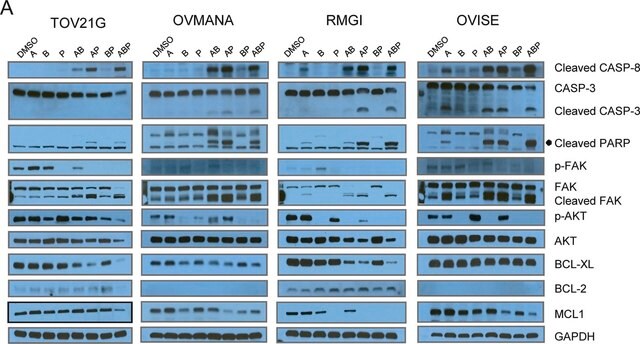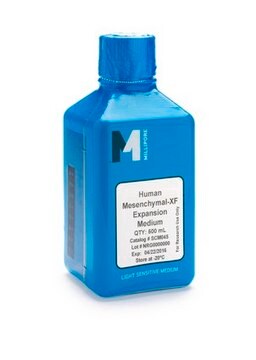17-229
Acetyl-Histone H4 Immunoprecipitation (ChIP) Assay Kit
Acetyl-Histone H4 Immunoprecipitation (ChIP) Assay Kit used to immunoprecipitate transcriptionally active chromatin from mammalian cells using anti-Acetyl-Histone H4, ChIP grade rabbit antiserum.
Anmeldenzur Ansicht organisationsspezifischer und vertraglich vereinbarter Preise
Alle Fotos(1)
About This Item
UNSPSC-Code:
12161503
eCl@ss:
32161000
Empfohlene Produkte
Qualitätsniveau
Hersteller/Markenname
Upstate®
Methode(n)
immunoprecipitation (IP): suitable
NCBI-Hinterlegungsnummer
UniProt-Hinterlegungsnummer
Versandbedingung
dry ice
Verwandte Kategorien
Allgemeine Beschreibung
For use to immunoprecipitate transcriptionally active chromatin from mammalian cells using anti-Acetyl-Histone H4, ChIP grade rabbit antiserum. Detection of the gene or promoter of interest in immunoprecipitated chromatin must be empirically determined by the researcher using quantitative PCR or Southern slot-blot analysis, using promotor specific primers or probe.
Anwendung
Acetyl-Histone H4 Immunoprecipitation (ChIP) Assay Kit used to immunoprecipitate transcriptionally active chromatin from mammalian cells using anti-Acetyl-Histone H4, ChIP grade rabbit antiserum.
Verpackung
Kit capacity: 22 assays
Komponenten
Anti-acetyl-Histone H4 (Cat.# 06-866)
Protein A agarose/Salmon Sperm DNA (Cat.# 16-157)
All necessary buffers
Protein A agarose/Salmon Sperm DNA (Cat.# 16-157)
All necessary buffers
Rechtliche Hinweise
UPSTATE is a registered trademark of Merck KGaA, Darmstadt, Germany
Haftungsausschluss
Unless otherwise stated in our catalog or other company documentation accompanying the product(s), our products are intended for research use only and are not to be used for any other purpose, which includes but is not limited to, unauthorized commercial uses, in vitro diagnostic uses, ex vivo or in vivo therapeutic uses or any type of consumption or application to humans or animals.
Signalwort
Warning
H-Sätze
Gefahreneinstufungen
Aquatic Chronic 3 - Eye Irrit. 2
Lagerklassenschlüssel
10 - Combustible liquids
WGK
WGK 3
Analysenzertifikate (COA)
Suchen Sie nach Analysenzertifikate (COA), indem Sie die Lot-/Chargennummer des Produkts eingeben. Lot- und Chargennummern sind auf dem Produktetikett hinter den Wörtern ‘Lot’ oder ‘Batch’ (Lot oder Charge) zu finden.
Besitzen Sie dieses Produkt bereits?
In der Dokumentenbibliothek finden Sie die Dokumentation zu den Produkten, die Sie kürzlich erworben haben.
Guocheng He et al.
Molecular and cellular biology, 22(9), 2965-2973 (2002-04-10)
Repression of human immunodeficiency virus type 1 (HIV-1) transcription may contribute to the establishment or maintenance of proviral quiescence in infected CD4(+) cells. The host factors YY1 and LSF cooperatively recruit histone deacetylase 1 (HDAC1) to the HIV-1 long terminal
Hui Liu et al.
Blood, 104(8), 2505-2513 (2004-07-01)
Cyclin D1 expression is deregulated by chromosome translocation in mantle cell lymphoma and a subset of multiple myeloma. The molecular mechanisms involved in long-distance gene deregulation remain obscure, although changes in acetylated histones and methylated CpG dinucleotides may be important.
Shaojing Chang et al.
Journal of immunology (Baltimore, Md. : 1950), 181(12), 8372-8381 (2008-12-04)
Forming and removing epigenetic histone marks at gene loci are central processes in differentiation. Here, we explored mechanisms establishing long-range H4 acetylation marks at the Ifng locus during Th1 lineage commitment. In Th0 cells, histone deacetylase (HDAC)-Sin3A complexes recruited to
Lata Balakrishnan et al.
Journal of molecular biology, 365(1), 18-30 (2006-10-24)
SV40 chromosomes undergoing transcription operationally defined by the presence of RNA polymerase II (RNAPII) were immune-selected with antibody to RNAPII and subjected to secondary chromatin immunoprecipitation with antibodies to hyperacetylated or unacetylated H4 or H3. Immune selection fragmentation and immunoprecipitation
Melker Göransson et al.
International journal of cancer, 115(4), 556-560 (2005-02-03)
The myxoid/round cell liposarcoma oncogene FUS-DDIT3 is the result of a translocation derived gene fusion between the splicing factor FUS and DDIT3. In order to investigate the downstream targets of DDIT3, and the transforming effects of the FUS-DDIT3 fusion protein
Unser Team von Wissenschaftlern verfügt über Erfahrung in allen Forschungsbereichen einschließlich Life Science, Materialwissenschaften, chemischer Synthese, Chromatographie, Analytik und vielen mehr..
Setzen Sie sich mit dem technischen Dienst in Verbindung.